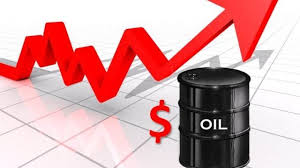At the back of sharp decline, and from their lowest point in terms of prices when the pandemic was initially unfolding last year, whereby on April 21, 2020 Brent crude stood at $19.33 a barrel, and the WTI (West Texas Intermediate) crude oil price had dipped a lot more at $11.57 a barrel, and both of them saw an overall steady increase till August last year.
Both Brent and WTI had peaked on August 26, 2020 at $46.16 a barrel, and at $43.39 a barrel, respectively, and after slightly steadying and somewhat falling the most by 30 October 2020– Brent stood at $37.94 a barrel, and WTI at $35.79 a barrel– both undertook a rising trajectory. On February 8, Brent broke the $60 a barrel barrier of the time just before the pandemic had impacted oil markets– which was on 20 February 2020 when Brent and WTI stood close to $60 a barrel, by being at $59.31 and $53.88 a barrel, respectively– whereby on this Monday Brent stood at $60.56 a barrel, while WTI had also closed in on by being at $57.97 a barrel that day.
Moreover, while reportedly downward risks to the outlook for oil prices remain in the short term, the outlook is expected to improve further over the medium term, as pointed out in a recent article ‘IEA says oil market recovery still fragile as virus persists’ published in Bloomberg whereby “Demand is running ahead of supply, and oil inventories are falling very, very sharply,” [Toril] Bosoni [International Energy Agency’s (IEA) head for the oil markets and industry division] said. As the stockpile decline gathers pace after the summer, it “sets the stage for OPEC+ to start unwinding cuts even if producers outside the group ramp up faster than currently projected,” the [IES’s monthly] report said. Over the course of 2021, about 60 percent of the demand lost last year should be recovered, according to the agency. World consumption will increase this year by 5.4 million barrels a day to average 96.4 million a day. In the short term however, market conditions face a temporary setback. Demand will decline by 1 million barrels this quarter versus late last year, and the IEA now forecasts that stockpiles will increase during the second quarter, having predicted last month that they would remain broadly steady.’
While vaccine introduction has provided a significant boost to oil demand rise in recent months, but it was the cut in supply, especially by Saudi Arabia that has provided a major impetus to the price rise, even when stricter lockdowns are making way at the back of both the second Covid-19 wave overall, but in particular due to the severity being caused by variants, and time needed to prepare effective vaccine boosters.
Hence, months of oil supply cuts, primarily led by Saudi Arabia had been the major reason, along with demand recovery in China in particular, where growth numbers and prospects have continued to improve for many months now, as reflected in rising oil demand in China, and also in India.
With regard to reductions in oil supply, Saudi Arabia, which is the largest producer of oil among OPEC+ (Organization for Petroleum Exporting Countries, including Russia among other partners) alliance had reportedly reduced oil supply the most during May-December 2020. That being said, the recent boost to prices was received mainly at the back of drastic reductions in oil supply by the Kingdom.
Arab News recently pointed out in this regard that ‘The price of crude oil rose above $60 a barrel on Monday for the first time in over a year, fuelled by the “Saudi surprise” cut in output. Brent, the global benchmark, touched $60.20, up more than 15 percent since the start of the year. West Texas Intermediate, the US benchmark that briefly fell into negative territory last April, leapt above $57 a barrel, also a 12-month high. Analysts raised their price targets for 2021, and gave most of the credit for the recent rise to Saudi Arabia’s decision in January to cut an extra 1 million barrels a day from global oil supply for two months. Bassam Fattouh, director of the Oxford Institute for Energy Studies, said: “Since the announcement of the cut, the oil price rallied despite the reintroduction of lockdowns in many parts of the world… Christyan Malek, head of oil and gas research at US investment bank JP Morgan— who has predicted the surge in crude prices for some time— told Arab News: “I can see the oil price overshooting significantly all the way up to $100.” ’
Hence, an approach that asks for a multi-sectoral and a highly prioritized focus, needs to be adopted in these very difficult times for the economy, as the government would likely remain torn between providing stimulus, and managing the macroeconomy. Above all, this would require moving away from the usual neoliberal recipe, which should require among first important steps to re-negotiate the programme with IMF, in which the country is currently engaged in.
While this is bound to help the economies of net oil-exporting countries, yet at the same time hold clear warning signs for macroeconomic stability for net oil importing countries, including Pakistan, which has already seen significant rise in domestic oil prices over the past many weeks. This is building up of imported-inflationary pressures, and would likely force the hand of the government to provide a much-needed stimulus in the coming months. Having said that, developing countries like Pakistan should not repeat the same mistake by over-sacrificing stimulus and economic growth for temporary relief on the macroeconomic front.
In case the same policy approach is repeated, it would most-probably bring disastrous economic consequences, especially for an economy in recession at the back of pandemic, with many being pushed below the poverty line for many months now. In this regard, the government should also remember that inflation is equally a fiscal/governance-related phenomenon in developing countries, and therefore, should not go into overdrive in terms of contractionary policies, but should focus on the governance/regulation aspect and correct market failures, and shape markets to block this significant inflationary channel.
At the same time, just like renowned economist Mariana Mazzucato recommends in her upcoming book Mission Economy: A Moonshot Guide to Changing Capitalism’, the government should target exports enhancement on a priority-basis and in a mission-oriented way, to allay resulting pressures on the balance of payments situation from rising import prices, especially oil. With regard to this approach Mazzucato points out ‘The pandemic has highlighted the cost of neglecting public investment, both in the welfare state and value creation. But the crisis has also created a huge opportunity to pursue industrial policies beyond traditional sectoral and technological silos, and to restore mission-driven governance in the public interest… As I explain in my new book Mission Economy: A Moonshot Guide to Changing Capitalism, landing a man on the moon required both an extremely capable public sector and a purpose-driven partnership with the private sector. Because we have dismantled these capabilities, we cannot hope to repeat earlier successes, let alone achieve ambitious targets such as those outlined in the Sustainable Development Goals (SDGs) and the Paris climate agreement.’
Hence, an approach that asks for a multi-sectoral and a highly prioritized focus, needs to be adopted in these very difficult times for the economy, as the government would likely remain torn between providing stimulus, and managing the macroeconomy. Above all, this would require moving away from the usual neoliberal recipe, which should require among first important steps to re-negotiate the programme with IMF, in which the country is currently engaged in.
























Thanks a lot for the great article.